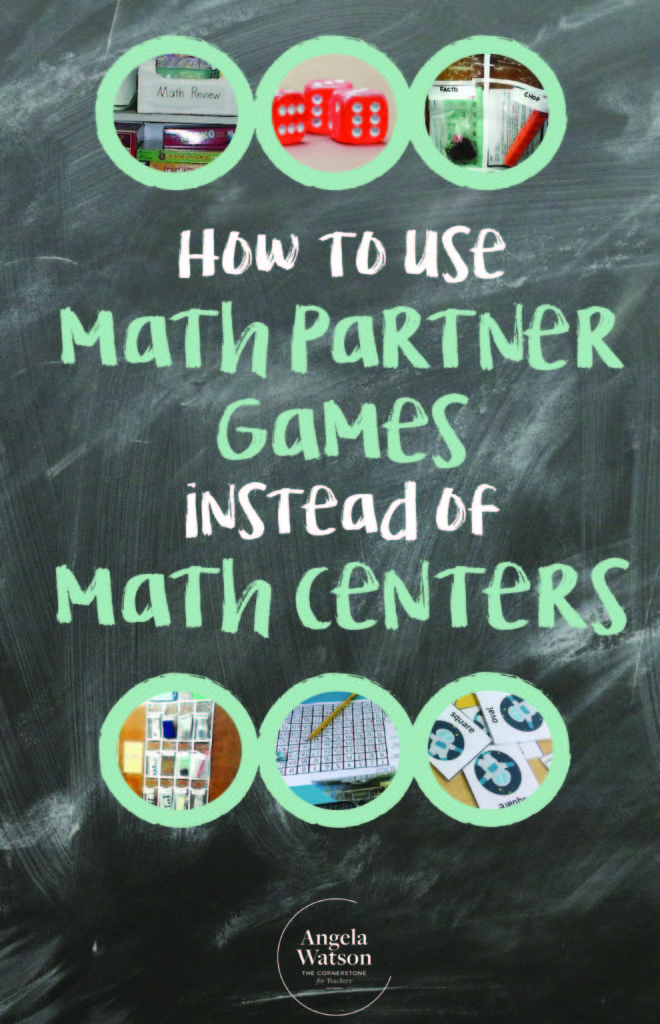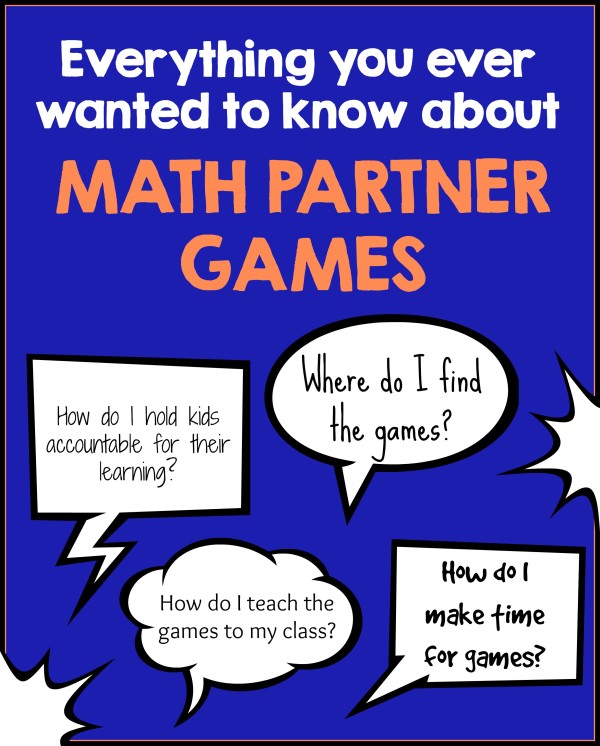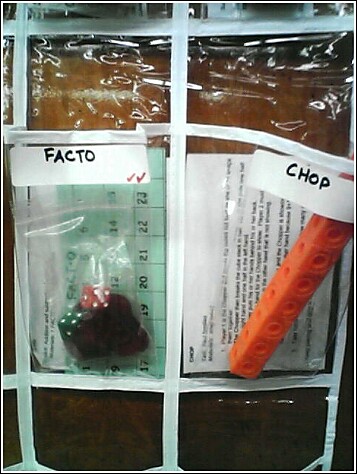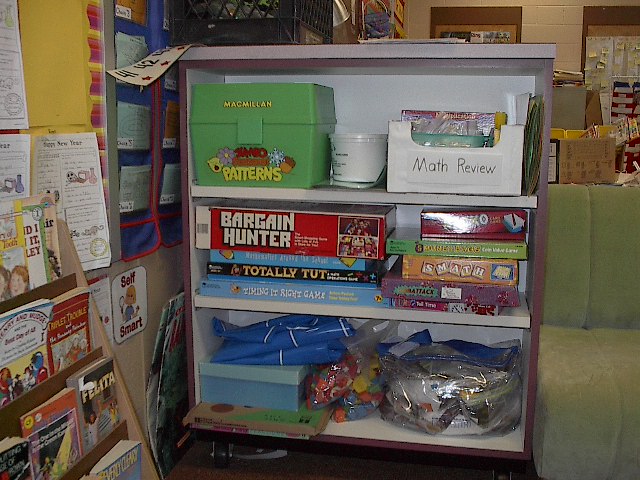Whether you’re looking specifically for math games or just want a fun way for students to practice math facts, the ideas on this page will help you incorporate a math partner game time into even the most limited class schedule. You’ll see how to store and organize the games and introduce them to your class. At the bottom of the page, you’ll find a link to the Math Games/Center Ideaspage where you can find math game photos and printables.

What’s a math partner game?
Similar to math tubs, the math partner games I use are two-player games that reinforce a variety of math skills, including problem solving and logical thinking. The games are open-ended and easily differentiated and individualized.
Are math partner games the same as math centers?
It depends on your definition. Typically in my classroom, partner game time is separate from center time because centers are independent activities while math games are multi-player and encourage discussion and collaborative problem solving. However, if you have students complete math centers cooperatively, then math partner games would be a perfect fit!
There IS one major difference between the partner game arrangement I describe here and typical centers. When kids are in centers, usually you the teacher are working with a small group. Since you’re busy teaching, it’s hard to tell whether the rest of the class is actually learning anything in their centers and games or if they’ve just mastered the art of looking busy.
During the math partner game set up I recommend here, you are not responsible for small group instruction, so you’re free to facilitate students’ thinking and engage kids in conversations about what they’re learning.

What are the advantages of using math partner games?
Math partner games are a great opportunity for the teacher to:
- Take anecdotal notes and/or assess children in meaningful scenarios
- Support students who are struggling academically as well as socially, because you’ll have the time to help solve disputes and model social problem solving skills
- Challenge high-achievers who are easily bored
- Allow students to actively construct knowledge through collaborative hands-on activities
- Model logistical thinking and encourage discussion (great since connecting words and math is difficult for many students)
- Provide problem solving and math skill practice that kids really enjoy
How many times do kids play the same game?
Generally, students play the same game for an entire week so that they have time to master the rules. Once they understand the basics, they really start focusing on the targeted math skills, determining patterns and strategies, and engaging in higher-level thinking discussions.
For how long do kids play the games?
I prefer to have pairs of students work with each game for 7-15 minutes daily. Though some games naturally lend themselves to the shorter or longer end of that range, ten minutes is pretty optimal and a good target to aim for.
Though most of the games end only when time is up, ALL of the games are open-ended enough that students won’t need to ask, “I’m done, now what should I do?” In the printable math partner games I’ve made, “Challenge” activity which you can have students do if they have time, or you can assign to certain students for differentiation. I usually have the class do the extra challenge for the last two or three days of the week, unless they haven’t yet shown proficiency with the basic level of game play.
My printable math partner games also include “Math Talk” questions which you can have students reflect on in writing using math journals or other formats. Once a week (or even more often), you may want to allow several extra minutes for students to talk or write about the Math Talk questions.
How do I make time for math partner games?
There are many ways to incorporate game time into your schedule. I prefer using them daily for up to 15 minutes, but I’ve also used them as fun math practice on Friday afternoons for about 25 minutes.
For awhile, my district required that I conduct standardized test prep/spiraling review practice with the kids for 20 minutes at the start of the math period. I chose to follow that with 10 minutes for math partner games, and then launched into my math concept/skill lesson for the day. The active, hands-on partner games were the perfect way to clear students’ heads before instruction resumed.
The fact that math partner games are a great way to break up long periods of direct instruction and guided practice is increasingly important as the CCSS moves us toward deeper study of math concepts. Many teachers now have longer math periods and are expected to spend several weeks on the same topic (whereas before, we might have only had several days per concept). Math partner games are a way to fill that extra time with meaningful opportunities for students to explore and talk about math concepts.
How are kids paired up?
I recommend that math game partners be selected by the teacher (rather than self-selected) so that students are paired homogeneously. This is important because if you have heterogeneous pairs (mixed ability levels), the less advanced child will lose frequently and get frustrated. Kids only enjoy playing the games if they regularly experience success and feel like they have a fair shot at winning.
Another reason why I think it’s better to pair kids with similar ability levels for math partner games is so that game play can be differentiated. You’ll be able to spend more time supporting your struggling students since they’ll be working together. And having your highest-performing kids paired together will be extremely valuable for them because they can play quickly and enjoy being challenged in a way that doesn’t always happen during the average mixed-ability cooperative activity. Since most of us have students work in mixed-ability groups throughout the school day, math partner games can be a rare opportunity for students to work one-on-one with another child who’s learning at a similar pace.
In addition, I think it’s important to consider students’ personalities when pairing. I don’t like to pair kids who know each other too well because they’ll play around, but if they don’t like each other or are both very shy or competitive, there can be problems as well.
I like to display a list so students can see who their partners are. Before sending students off to play the games, I usually have the class look at the list and raise their hand if their partner is not in the room so that I can re-partner students for the day as needed. I generally make changes to the partner list based on my observations and student input. I’ve found that some kids want to keep the same partner for months, but most kids want to change partners every few weeks, and I try to accommodate them either way so they enjoy the games more.
For variety, I do allow students to pick any partner they want on special occasions (short weeks, days when we have an assembly and the math block is cut short, etc.) as well as when we go back to review previously taught skills. Some kids choose to play with friends that are more or less advanced than them, and that allows them to experience the game in a different way. Interestingly, I’ve found that about half the students still choose their regular math game partner: the kids tend to get into certain rhythms and playing styles and enjoy the familiarity.
Can students choose the game they want to play?
Yes! After 5-6 weeks (when you have introduced 5 or 6 games), you can let each set of partners choose one of the games to play, and have the class practice playing different games at the same time. I highly recommend doing that occasionally throughout the year, such as:
- Short weeks when you only have school for 2-3 days and therefore don’t want to introduce a new game.
- When you want to review a variety of skills and concepts. Do two or three 10 minute sessions back to back, and let kids change their games for each session.
- When a lot of students absent: let kids pick their own partners and own games for a special treat.
- At the end of the year when you have already introduced all the games.
When students are all playing different games, you may need to have printed directions available in case kids forget the rules. You should also talk with students about what they should do if they get stuck.
How do I introduce math partner games to my class?
I strongly recommend that you model how to play the games FIRST. Introduce the games one at a time to your class, one game per week. During the modeling, you can demonstrate the basics of the game by playing against a volunteer. I used an Elmo (document camera) to help with this, placing the pieces under the Elmo so the class could see what was happening. I then guided two other volunteers as they played together for the class. This technique is a great way to model mathematical thinking and reasoning and draw attention to the math strategies you want students to use.
Right after the modeling/demonstration, release students to try playing the game with their partners. If you see a lot of kids making the same mistakes or demonstrating major misconceptions, end the game play time a little early. Talk about it afterward, and do more modeling the next day.
For younger students (and for most classes at the beginning of the year), I’d suggest modeling the game on the first two days students play it. The first day, your demonstration should be very in-depth and focus on what to do if kids get stuck or disagree with one another, as well as what to do when they’re finished and how to clean up the game properly. The second day’s demonstration can focus more on applying math skills and strategies. I often do two or three days of demonstrations/skill mini lessons with more complex games, even if it’s just quick refresher with two student volunteers before releasing the rest of the class to play.
Why not have kids play all different games at once, like in math centers?
I like having the whole class play the same game because you can conduct mini-lessons/strategy discussions around shared experiences before and after game play. Also, since students play the same game for a week, you have lots of targeted opportunities for identifying and addressing misconceptions and scaffolding student learning.
How do I open the math partner game time?
When you first introduce a game at the beginning of the week, you’ll start your math partner game time with modeling. By mid-week, you can start the time with a mini lesson focusing on the higher-order thinking skills you want students to develop. You can pose particular scenarios that might arise during game play and have students suggest strategies for solving them, or mention a challenge that one team of students experienced the day before and have students talk about what they would do. You can also mention any classroom management issues that arose, or remind students of strategies you’d like them to use.
How do I close the math partner game time?
You can end the math partner game time with a whole-class debriefing session. Students can talk about what strategies worked well and which didn’t. Students can also reflect on these questions in writing (i.e. in math journals), or by talking with their partner (or a different partner in a turn and talk/think-pair-share activity.)
You can switch up your approach as needed, or make a schedule and debrief in a different way each day of the week. Again, the conversations will be more superficial at the beginning of the week and will move toward critical thinking as students have more experiences with the game.
How do I store and organize math partner games?
If you’re using the math partner game system, you’ll need to have half a class set of all your games. In other words, if you have 26 students, you need 13 sets of each game. The type of organizational system you choose should be based on the materials you have and the size/type of your math games. If you have lots of larger materials, you’ll need to consider that in your planning. I’ll share with you the systems I’ve used over the years, and then explain what I think is the best way to organize and distribute the printable math games I’ve made.
My first year using math partner games, I simply had a milk crate full of plastic baggies with materials inside. As my collection of games grew, I started keeping the plastic baggies in plastic tubs (containers). Some were the small kind you’d find at the dollar store and some were larger like dishwashing tubs, depending on the size of the materials that went inside.

Eventually I found the toy organizer you see pictured above. (Mine was from Big Lots, but I believe you can still get something similar at Target.) I used the large, colorful bins to hold the partner games my class was currently using. There was one bin for each game, and each bin held the entire half class set of materials for that game. For most games, I had a plastic baggie or manila envelope for each pair of students, so the bin for a certain game usually had about a dozen baggies or envelopes inside. The games for units we weren’t currently studying were hidden away in cabinets or other plastic containers.
I also kept one set of each game in a hanging shoe organizer, which you can see hanging on the door in the left hand picture above and as a close up in the right hand picture above. Later in the school year, I’d allow students to choose the game they wanted to play. Each set of partners would simply walk over to the shoe organizer, pick a game and take out the materials, then return them after game play. I also allowed students to use the games in the shoe organizer at other times in the day (before and after school, during indoor recess, etc.) We called it “Free Choice Math Partner Games“. I had a milk crate to hold the games that were too large to fit in the shoe organizer.
How do I pass out and collect the games?
When you’re ready for students to play a game, place the file folder full of game mats (or other materials) and the set of baggies of smaller materials on a table. Have all the “Partner 1s” in your math partner list come up to the table in an orderly line and take one of everything. The Partner 2’s are responsible for returning the materials to the same spot after game play.
If you practice your expectations for this, the system for distributing and collecting game materials will go very, very quickly. Sometimes it helps to set a timer for one minute: at the end of the minute, all the partner 1s should have the necessary materials and both partners everyone should be in their “spot” in the room where they play the math partner games. If there is any pair of students who has not yet begun game play when the timer goes off, you can assist them with whatever they need to get started.
Can I use games I already have?

Yes! I have used lots of board games and pre-made materials that I had from my childhood or yard sales. This photo shows where I stored the math tub activities I was not currently using (in my Washington, D.C. third grade classroom). The green box holds games in plastic bags. The round plastic container (which used to hold kettle corn from the beach) contains miniature playing card sets from the dollar store that the students use to play whole class games of Battle. The Math Review box (which used to hold pasta in Wal-Mart- I took it and covered it in white paper) holds math bingo games and flashcards. Underneath are board games that were either designed to reinforce math skills, or contain altered rules I created to make them educational and appropriate for young children. (I also use Scrabble, Scrabble Junior, Go For Broke (no longer made), a version I made of Risk, and sometimes Monopoly. You can see Rack-O in the picture–that’s a cheap and wonderful game that provides number order/greater than/less than practice). On the bottom shelf is a big blue mat divided into squares- I’m not sure where it came from, but I use it as a Jeopardy board with clues written on sticky note. Random manipulatives are kept on the bottom, including dice, which are often used for whole class games, as well.
What if I don’t have the time and energy make my own math partner games?
I am in the process of creating printable math partner games for every Common Core domain for grades 1-5! That includes Operations and Algebraic Thinking, Number and Operations in Base Ten, Fractions, Measurement and Data, and Geometry. Click through the slideshow to see the games for each domain and grade level:
The games include “Challenge” sections, which you can offer the challenge as an option for students if they’d like to try, or assign them only to certain students to differentiate game play. Another idea is to use that section after students have played the regular way several times, or later in the school year when reviewing previously taught skills.
The math partner games also have “Math Talk.” You can teach students to talk about these questions with their partners, or ask the questions yourself as an informal assessment while observing game play. Or, use the Math Talk questions to facilitate mini-lessons and/or debriefing sessions before and after game play. The questions also work well as math journal prompts and written reflection topics.
The math games could also be used in math centers,, math tubs, math work stations, etc. You could choose to play some of the games using the system I describe here, and place the rest in centers for kids to explore independently.
To receive an email notification when new skills and grade levels are added, follow my store on TeachersPayTeachers! Thank you for your support!

Angela Watson
Founder and Writer
Sign up to get new Truth for Teachers articles in your inbox
Discussion
Leave a Reply
OR

Join our
community
of educators
If you are a teacher who is interested in contributing to the Truth for Teachers website, please click here for more information.
















Thanks for this article! I’m a first year kinder teacher and have really been going back and forth about whether I should use math centers or partner games. I tend to agree with your points above about the benefits of having the whole class working on one concept at the same time. My teaching partners do 5 math centers, and I’ve been trying to do that as well, but I’m just not feeling like my kids are on task while I am working with my small groups. It’s also a challenge to model 5 different centers, especially because I like to change them up often.
My mentor teacher last year used partner games, but the kids were all fairly high and homogenous. My class is made up of a wide range of abilities, so I feel like I have so much more that I need to cover (which leads me back to question whether centers is more effective in this situation.)
Do you feel that partner work can work effectively in kindergarten or is this article directed towards the older grades?
Thanks!
Kate
Yes, I do know of kindergarteners who use this concept–I just haven’t created the games for them. You can adapt your existing games and center activities for sure.
Hello, thank you for all the nice things and information you have provided. I am a first year teacher just got hired for a math teacher grades 3rd, 4th, & 5th grade. I would like to know what math schedule do you recommend for a 90 minute block. Thanks
I love this idea. Any chance you’ll be developing partner games for 6th grade math?
Any chance you would have 8th grade resources for this idea.??
No, I don’t. I’m sorry!
Great ideas!